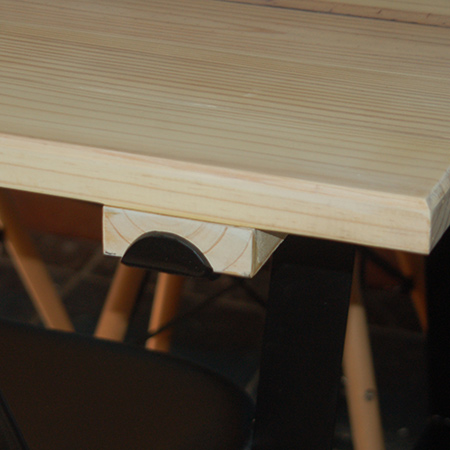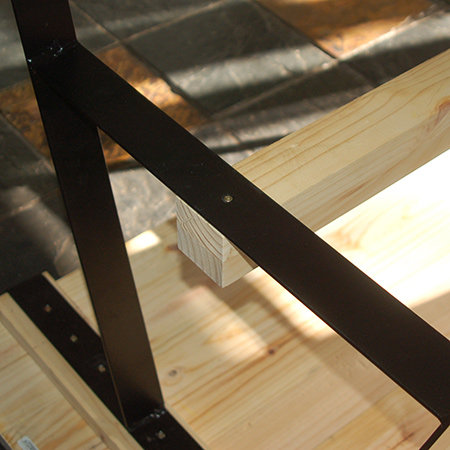Make a Pine Dining Table for Indoors or Outdoors
This pine dining table for originally intended for indoor use but was later relegated to being an outdoor dining table and have served its purpose well for the past 7 years and is affordable and easy to make.
21/10/2023
I made the table in 2016 and it was intended
to replace the old dining table that I had. I
got the idea for the table from something I had
seen in a furniture store that came with a
whopping price tag. Knowing I could make it for
a fraction of the price and even better quality, I purchased all the
materials needed at Builders and had a friend of
mine who does welding make the base for the
table. The legs worked out at R150 and the table
cost R2000, which is expensive I admit but I did
use 32mm thick pine for the tabletop rather than
the standard 19/21mm thickness. Something to
keep in mind if you want to make the table but
would prefer to spend less.
If you do not know of someone who does
welding for a hobby, there are plenty of welders
out there for hire who could make the table legs
for you and it shouldn't cost that much.
Below, you will find
detailed step-by-step instructions
for making the pine dining table as well as a quick and easy
whitewashing method I used to remove the pine
'yellow' effect from the wood. You can use this
method on any pine furniture or pine fitting and
it really does lighten the colour of the pine.
The dining table and chairs that were replaced were old fashioned and the tabletop was scratched. The dining space definitely needed something modern to fill the space.
There are two things I did when making the table that are important and why I think that the table has not warped or bowed in any way, despite being outdoors for the past 3 years and these are 1) The cross-support beam that is mounted underneath the tabletop and the edge frame of the leg assemblies. Both of these prevent any expansion or subsequent bowing, despite the fact that the table has been kept outdoors for the past 3 years.
I enlisted the help of a friend who does welding to make the steel leg frames for the table, and these only cost R800 for the pair. The wood for the table cost R1100 at my local Builders Warehouse, and that includes the fact that I used a 32mm thick pine rather than go for a thinner 20/22mm pine. So, at the end of the day my much stronger and sturdier table came in at a cost of around R2000.
YOU WILL NEED:
11 of 32 x 94 x 1800mm PAR pine planks*
1 of 67 x 67 x 1800mm PAR pine
2 steel leg frames
Ponal wood glue
4,5 x 50mm screws [20]
4,5 x 60mm screws [2]
TOOLS:
Drill / Driver plus assorted bits
Biscuit Joiner and #20 biscuits (or see below for alternatives)
Orbital Sander plus 120- and 240-grit sanding pads
Quick clamps [2]
OPTIONAL: Bessey Clamps used below for laminating planks
OPTIONAL: Dremel Trio or Router
*Make sure that all the planks are straight and now bowed, and that there is little or no knots in the planks. You can work with a few knots here and there, but larger ones will eventually end up being a problem.
HERE'S HOW:
Preparation
Remove the edge of each plank to remove the protective sealer. This will give you a smooth edge to work with. Also check that all the planks are exactly the same length, or trim as necessary with a jigsaw, mitre saw or tablesaw.
Step 1 - Use a Biscuit Joiner or Pocket Hole Jig
To join the individual planks together I will be using biscuit joints. If you don't have a Biscuit Joiner you can use a Kreg Pocket hole Jig, or simply glue the planks together. All these methods use Ponal wood glue between the planks and are clamped overnight. Place the planks with their face down on a flat work surface.
GOOD TO KNOW
When cutting the slots or using a pocket hole jig, it is important to make sure the planks are absolutely flat. To do this, I placed a clamp at every position where slots will be cut. If you don't do this, you run the risk of having the planks at differing heights across the width of the tabletop.
Step 2 - Prepare for laminating
To ensure flush and secure fitting, I cut four slots along the total length of each plank. After using the biscuit joiner, the planks were placed with the slots face up and wood glue poured into the slots before inserting the biscuits. These were then left to settle for a couple of hours.
GOOD TO KNOW
By using this method it is easy to clean up glue that oozes out of the cut slots and gives the biscuits time to absorb the glue and swell to lock in place before joining to the other side.
Step 3 - Laminating the tabletop
Returning to the tabletop, glue was poured in the opposing slots to enable the planks to be slotted together. Have a rubber or wood malet on hand in case you need to give the planks a little help in fitting tightly together before clamping the assembly. I clamped the entire table with my Bessey clamps and left it overnight. If you don't have monsters like these in your workshop, place something heavy on either side hold everything together while the glue dries.
If you do not possess a Biscuit Joiner, you can use a Kreg Pocket Hole Jig to assemble the pieces for the tabletop.
GOOD TO KNOW
The reason it was important to place the planks face-side down was to allow for fitting a crossbeam across the glued planks, and you don't have to move the planks to do this if they are already face down.
Step 4 - Adding the cross-beam support
For this next step there has been a bit of controversy. When placing this project in Easy DIY magazine a comment received stated that this method for joining the table would not work - there would be too much movement. For the past year I have closely checked the table to see the amount of movement - and we have experienced hot and wet weather - and there has been hardly any. So, glue the cross piece to the underside of the table and then insert [2] screws through the cross piece into each plank - at either side.
Step 6 - Neaten the edge of the tabletop
To finish off the edges around the table I used my Dremel Trio and a 'V' cutting bit to chamfer the edge at a 45-degree angle - or use a router. Since the Dremel Trio is no longer available, sadly, you can use a router for this step. The entire table was then sanded, first with 120-grit to ensure an even finish and then with 240-grit to make it nice and smooth.
Finishing
I'm not a big fan of pine purely because I don't like the yellow colour. Then I came up with the idea to give the table a very light whitewash finish to diminish the naturally yellow colour. Note: If you want a darker finish, apply wood stain in your choice of wood tint and then apply interior sealer for indoors or exterior sealer if the table is to be used outdoors.
I used matt white paint and poured this into a container, slowly adding water and testing this on scrap blocks of wood until I achieved the level of whiteness necessary to take away the yellow.
Bottom block is raw pine - Top block is too white - I went with the middle block
Some whitewashing methods require that you use a wire brush over the surface to raise the grain before applying the paint. Pine, however, is a softwood and the paint is easily and quickly absorbed into the surface. I used a sponge to apply and had a second (dry) sponge on hand to wipe away excess as quickly as possible.
GOOD TO KNOW
Continuously stir the watered-down paint as you work.
Working from one end to the other - one plank at a time - dip the sponge into the paint and squeeze out excess before wiping along the length as quickly as possible.
The table after whitewashing. I put an unpainted piece of pine on top so that you can see the difference. The white paint has taken away most of the yellow.
To ensure the table is protected, I applied 3 coats of Woodoc 5 Polywax matt sealer. I don't want a gloss finish on the table and the matt is more natural once dry. Follow the instructions on the can for proper application.
You can see that the sealer has not yellowed once applied and will ensure the table is adequately protected. Periodic application, say every 18 to 24 months is necessary.
Assembly
The steel leg frames are 700mm high and 940mm wide, excluding the lip at the edge. This is the exact width of the finished table.
GOOD TO KNOW
The lip at both sides of each leg assembly holds the tabletop firmly in place and reduces the possibility of expansion of the wood.
Place the tabletop face down in order to mount the steel leg frames onto the crossbeam using 4,5 x 50mm screws.

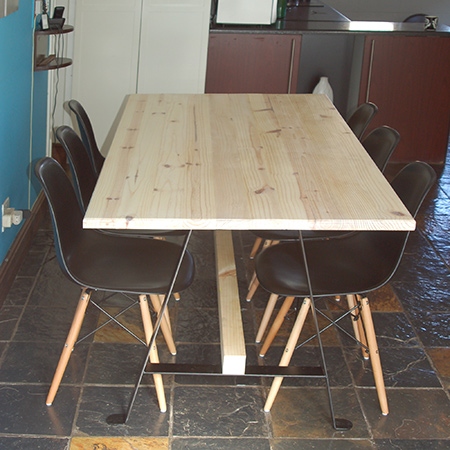
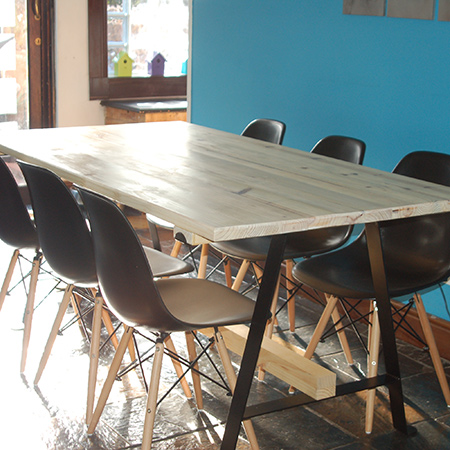
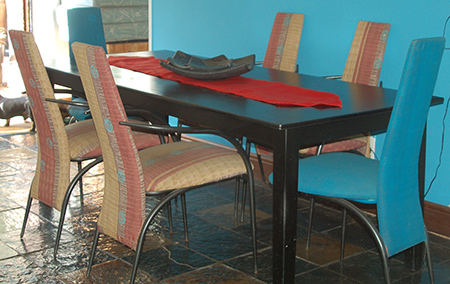








![glue the cross piece to the underside of the table and then insert [2] screws through the cross piece into each plank - at either side.](../2016/may/145a.jpg)








